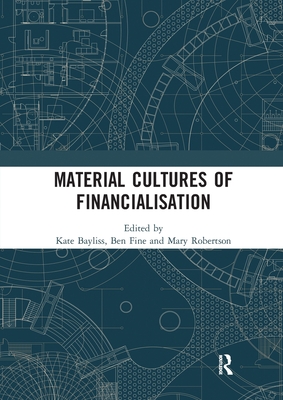Analyses of financialisation have been diverse and wide-ranging with economic analyses at one extreme, and the cultural at the other. This book uniquely and critically integrates different approaches together to provide a pathbreaking approach to the material cultures of financialisation, together with a variety of case studies. The chapters wer
This collection offers pathbreaking framing of the material culture of financialisation. It begins with a tight definition of financialisation in order to distinguish the phenomenon of financialisation from its effects and from the looser associations prevalent within much of the literature such as the presence of credit or even simply (more extensive) monetary relations. To locate financialisation within economic and social reproduction, of which material culture is a part, close attention is paid to the distinctive forms of financialisation arising from commodification, commodity form and commodity calculation. The differences in the extent to which, and how, these prevail are addressed through the innovative system of provision approach and its framing of material culture through use of ten distinctive attributes of such cultures, known as the 10Cs (Constructed, Construed, Conforming, Commodified, Contextual, Contradictory, Closed, Contested, Collective and Chaotic). This framing of the cultures attached to financialisation is then illustrated through case studies demonstrating the diverse ways in which shifting cultures have served to embed financialisation in our daily lives. After a discussion of the material culture of financialisation itself there are two sector examples which review financial cultures in the provision of water and housing. These are followed by considerations of financialisation in financial literacy and financial inclusion, the media and, finally, well-being.
The chapters in this book were originally published in a special issue of New Political Economy.
Get Material Cultures of Financialisation by at the best price and quality guranteed only at Werezi Africa largest book ecommerce store. The book was published by Taylor & Francis Ltd and it has pages. Enjoy Shopping Best Offers & Deals on books Online from Werezi - Receive at your doorstep - Fast Delivery - Secure mode of Payment
 Jacket, Women
Jacket, Women
 Woolend Jacket
Woolend Jacket
 Western denim
Western denim
 Mini Dresss
Mini Dresss
 Jacket, Women
Jacket, Women
 Woolend Jacket
Woolend Jacket
 Western denim
Western denim
 Mini Dresss
Mini Dresss
 Jacket, Women
Jacket, Women
 Woolend Jacket
Woolend Jacket
 Western denim
Western denim
 Mini Dresss
Mini Dresss
 Jacket, Women
Jacket, Women
 Woolend Jacket
Woolend Jacket
 Western denim
Western denim
 Mini Dresss
Mini Dresss
 Jacket, Women
Jacket, Women
 Woolend Jacket
Woolend Jacket
 Western denim
Western denim
 Mini Dresss
Mini Dresss






























































